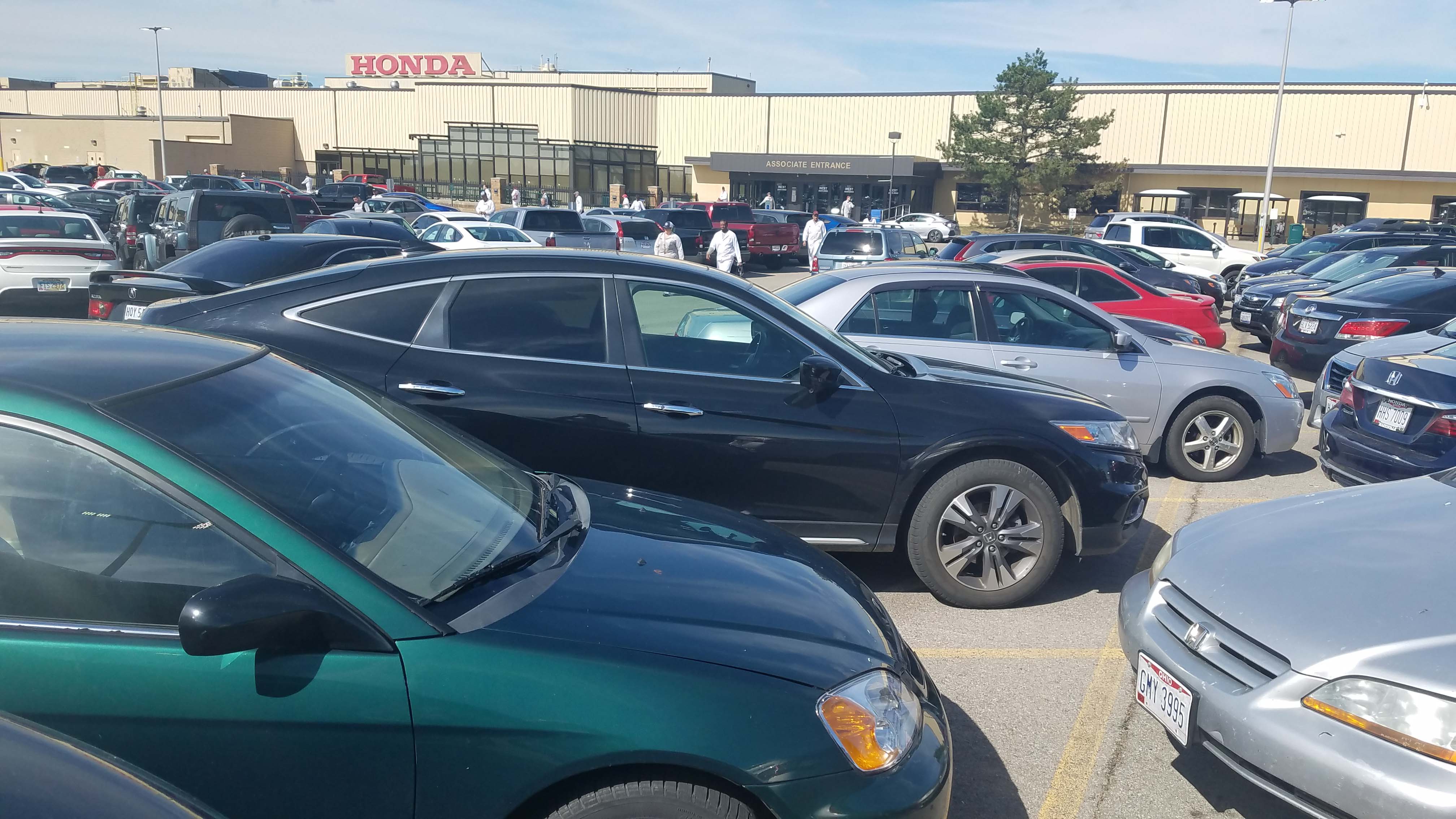Honda Marysville: A non-union auto plant prospers
 Henry Payne
Henry Payne
Marysville, Ohio — While the United Auto Workers strike against General Motors Co. plants stretches on, it's been business as usual here at Honda Motor Co.’s Marysville assembly.
Celebrating its 40th year of production this month, the non-union plant has never had a work stoppage as it has pumped out two of the most popular vehicles in America: the Honda Accord sedan and CR-V SUV.
Honda Marysville is not alone.
Dozens of so-called foreign "transplants” — from Asian mainstream manufacturers to European luxury makers — have followed Honda’s model across the United States in recent decades. The influx has transformed America’s auto landscape with a cheaper, more flexible, non-union workforce model upping competitive pressure on unionized Detroit.
Today, the Detroit Three automakers are an island of UAW production surrounded by foreign transplants that now make up 48% of U.S. vehicle production, according to the Ann Arbor-based Center for Automotive Research. That's up from just 17% in 2000. Non-union employment rose from 15% of the industry at the century's turn to 39% in 2013, according to the most recent Automotive News analysis.
“Unions are not dead,” said East Lansing-based economist Patrick Anderson, who noted the strike is costing GM $25 million per day in lost profits. “But confrontational, obstructionist bargaining as a success strategy is dead. Unions are here to stay only if they are interested in the welfare of their employers as well as their workers.”
The UAW says that non-union plants are at a disadvantage because union wages are better, the shops are safer, workers' rights are better represented and disciplinary actions are covered by a grievance procedure. But UAW efforts to organize foreign-owned auto plants in the United States have failed repeatedly, despite promises of contract protections and generally higher pay.
In response to inquiries from The Detroit News, the union said: "As a matter of policy, the UAW does not comment on organizing plans and strategies." Still, compensation in UAW-represented auto plants trends higher nationwide than non-union shops.
Average hourly wages in non-union transplants run between $23 and $25 an hour, according to the Center for Automotive Research, compared to roughly $30 an hour for so-called "legacy" employees at UAW-represented auto plants. Health-care plans and 401(k) programs are common, and bonuses are comparable to UAW-bargained profit-sharing payouts.
Honda’s Marysville is not immune to change. Like the rest of the industry, the plant has been whipsawed by changing market forces. The Honda Accord — the first sedan manufactured here beginning in 1982 — is down in sales as consumer tastes have shifted to SUVs. But rather than shutter Marysville, as has happened at GM's sedan-only plant in Lordstown, Ohio, Honda has expanded production for its new best-seller, the CR-V SUV.
Honda employs 15,000 people in its facilities across Ohio — 4,700 in Marysville — making it Ohio's 13th-largest employer, according to Cleveland.com. By comparison, GM employs 17,000 hourly workers across Michigan.
“Honda has been good to us,” said 32-year Marysville veteran Merrill Eggleston, 59, at the end of his shift in the plant’s weld shop. “... The UAW tried to get in here, but we have always had stable employment.”
Honda’s manufacturing flexibility and continued investment here — it has opened two more plants in the north Columbus area as well as expanded research on autonomous vehicles — have grown a loyal workforce.
“We don’t have a problem here. Which is good because we are privileged to have a job — Honda could just shut down and move away,” said radiator-and-headlight assembly worker Neal Howard, 49, who has worked here 19 years. “There is nothing to fight about. We have a good culture here, people just want to work.”
Eggleston and Howard’s sentiments were echoed by other associates interviewed at the end of a long day. They were all aware of the UAW strike but said relations with Honda were good.
“Honda works well with us,” said Brittany Mowry, 26, a full-time associate who started as a temporary worker in Marysville in 2011. “We’ve never had an issue.”
Honda first purchased land in Marysville in 1977 to build a motorcycle production facility. The decision proved prescient as Congress, led by Midwest Democrats like the late U.S. Rep. John Dingell, sought to impose import quotas on foreign cars as they grabbed more market share from the Detroit Three. The Accord began production here in 1982.
Executives at Honda were determined to build in the markets where they sold, and the United States held huge potential. In the midst of difficult economic times in the late 1970s and early '80s, Ohio welcomed Honda with open arms after then-Gov. Jim Rhodes traveled to Japan to sell the company on the Buckeye state.
“He met with Mr. Honda, and they forged a real bond,” said engineer Steve Stolte, who surveyed the first 217-acre property that Honda purchased in Marysville. “Honda had a philosophy where they wanted to build cars in those markets where they were selling them.”
Stolte is now a commissioner in Union County, where Honda now occupies 8,500 acres of land. That workforce was largely agrarian before Honda, though Union County is home to other large companies like Scotts Miracle-Gro and Parker-Hannifin.
“This county was experiencing double-digit unemployment before Honda showed up,” county economic development director Eric Phillips said. “Today, we are the third-wealthiest county in the state with one of the lowest unemployment figures."
Union County's jobless rate was 3.5% in August; statewide, it was 4.2%. Locals now like to say: "In Union County, we know how to grow beans, corn and cars."
Phillips is aware of the strikes in UAW plants but says the Marysville plants have been content and UAW attempts to organize workers here got no traction. County officials say the UAW had an office in Marysville until about 10 years ago.
“Honda is the pay standard here," Phillips said. "Their average wage of $80,000 pays well. If you have a good-paying job, then folks are going to be pretty happy.”
Howard worked as a bank supervisor before he came to work for Honda.
“This pays a lot better than a bank,” he said.
The automaker's pattern of high-paying, non-union employment has been repeated across the country in transplants from Toyota Motor Corp. in Kentucky to BMW AG in South Carolina to Kia in Georgia to Volkswagen AG in Tennessee. Sales of Detroit Three competitors have grown from 35% of U.S. market share in 2000 to about 55% today, according to CAR.
The transplants have long had a cost advantage over UAW plants. In 2007, before GM's bankruptcy, Detroit Three plants hourly labor costs averaged $78 an hour (wages plus benefits), according to CAR, compared to $47 an hour for non-union plants. Closing that gap was a crucial requirement of the 2009 federal bailout of GM and Chrysler, and it remains a competitive challenge in this fall's contract talks between the UAW and the Detroit Three.
Today, says CAR’s Kristin Dziczek, that gap has been narrowed to $63 for GM's UAW plants versus $50 for non-union. But that doesn’t tell the whole story as transplants still have the flexibility to peg their wages to local manufacturing norms in different communities where they build.
“The transplants can set regional wages,” Dziczek said. “GM can’t do that. The Detroit Three negotiate national pattern agreements with the UAW so that they don’t compete against each other on wages.”
The lack of wage and workplace flexibility add up to big drags on the efficiency of UAW plants versus their non-union competitors.
“At Honda, everybody is an associate, so that allows a more flexible workforce. There is not the multiplicity of job classifications as in union plants,” said Auto Trends Consulting’s Joe Phillippi, a longtime industry analyst. “In a UAW plant, no one can do someone else’s job. You don’t have the spirit of teamwork like you do in a non-union plant.”
Added Anderson, the East Lansing economist: "No question a labor cost advantage can be put into higher quality and higher dealer margins."
The Georgia-built, $40,000 three-row Kia Telluride SUV, for example, is marketed at $5,000 less than a comparable Ford Explorer built in Chicago.
Credit Suisse's Dan Levy estimates the strike could cost GM more than $50 million per day, but industry watchers say the GM/UAW negotiations are crucial to the long-term survival of the Detroit Three automakers if they are to stem the relentless take of market share from foreign transplants.
“GM and the UAW have to figure out which century they are in,” Anderson said. “Since the bankruptcy, GM has made itself a 21st-century company talking publicly about competitive wages and closing plants to remain profitable. But the UAW and their political supporters are still using rhetoric right out of 1979. It’s not clear that they understand that the game has changed.”
Henry Payne is auto critic for The Detroit News. Find him at hpayne@detroitnews.com or Twitter @HenryEPayne. Catch “Car Radio with Henry Payne” from noon-2 p.m. Saturdays on 910 AM Superstation.